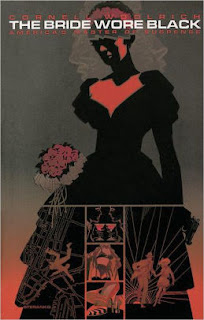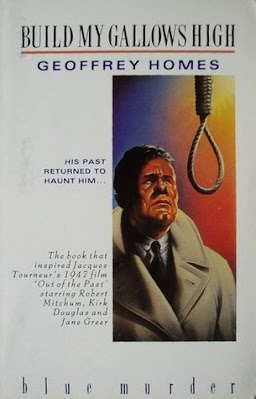I like to link my reviews to Amazon in the event someone wishes to purchase the book. Guess what,
Build My Gallows High is out of print and available copies are very expensive. I was fortunate to get my copy through a paperback exchange. Why this noir classic is out of print is a mystery ... and a crime.
I am a staunch Penzlerite when it comes to noir. In the article Noir Fiction is About Losers, Not Private Eyes Otto Penzler says
Look, noir is about losers. The characters in these existential, nihilistic tales are doomed. They may not die, but they probably should, as the life that awaits them is certain to be so ugly, so lost and lonely, that they’d be better off just curling up and getting it over with. And, let’s face it, they deserve it.
While you might find yourself rooting for the protagonist of Build My Gallows High, you're pretty sure it isn't going to turn out well for him.
I am also going to write about Out of the Past, the film adaptation. Be aware, I am not going to avoid spoilers. If you want to read the book or watch the film without foreknowledge, stop now.
At only 154 pages, this is a remarkably complex yet compact story, full of double-crosses. Red Bailey isn't the bad man you find in most noir but he still finds himself in a noir downward spiral to doom.
When the book opens, Red is running a gas station in Bridgeport, California (a real place). It seems idyllic existence, a business hat pays the bills with a little left over and a young, local, innocent woman, Ann Miller, who is in love with him. Red hold her off, telling her he is unworthy. He isn't very forthcoming about himself and he evidently has a darker past. He tells himself
The past was dead. Ten years dead, and buried deep.
complicating their relationship is Jimmy Caldwell who has known Ann since childhood and desperately wants to marry her. He is bitter about Ann's relationship with Red.
But the past does catches up with him when he finds Joe Stefanos waiting for him at the gas station. Joe works for Guy Parker who Red knows from when Guy was a police chief. Guy has a job for Red and sent Joe to fetch Red, at gunpoint if necessary. Before he leaves with Stefanos, Red finally professes his love to Ann telling her he wants to get his past behind him once and for all.
Guy wants Red to go to New York and sort out a fellow, Lloyd Eels, who is bothering a friend of his. He insists that Red is the only person for the job. Red used to be a private detective and he once helped out Parker in San Francisco when parker was a police chief. A woman joins them, Mumsie McGonigle, someone else from Red's past. This leads to a flashback.
Red had been hired by a gangster/gambler named Whit Sterling to locate Mumsie who had shot Whit and left with a lot of money. Red does track her down in Acapulco Mexico but falls for her hard. Instead of taking her and the money back, Red returns to NY, tells Whit he couldn't find her, sells out to his partner, Fisher, and he and Mumsie settle in Los Angeles where he opens a detective agency and meets Guy for the first time.
Their idyllic life comes to a crashing end when Fisher tracks them down to a rustic cabin they rented for a get-away. He wants the money Mumsie stole from Whit and in return he won't tell Whit where they are. There is a struggle, a gun goes off, and Fisher is dead, accidentally shot. Red buries Fisher but Mumsie takes off. Despite her denials, Red knows she has the money but he has a fatalistic attitude:
He'd get over it, he knew. He'd be lonely for a while, lonely for a myth. And Mumsie,? With that wad of money she should be very happy, Money was something you could hold and count, Love? Hell, you could pick that up in a Mexican cafe when you needed it.
Red betrays Whit for Mumsie and Mumsie betrays Red for money and to escape anything blowing back on her from Fisher's death. When Red meets Mumsie again with Guy, it come out that Guy knows everything about Red, Mumsie, and Fisher. Mumsie tells Red she didn't sell him out but Red doesn't believe her. Red thought he had a good and settled life with Mumsie but it crashed. Now he hopes for a good life with Ann. His life seems to be repeating itself.
In NY, Red figures out that this isn't a simple strong-arm job. He's being put in the frame as part of a larger scheme. Eels was an accountant who had record that would put Whit away. Eels is killed and an affidavit left in his safe implicating Red in Fisher's death. He's being framed as an act of revenge by Whit. Red gets the records but before he can get the affidavit out of the safe, the police arrive at Eels' apartment. Soon it's in the news which reaches Bridgeport. Red is a murderer and the subject of a manhunt.
Red makes his way back to Guy and blackmails him and Whit to get the affidavit retracted and set up Joe Stefanos and Mumsie for the murders. Whit agrees to give money to go away and plane to take him to Mexico. When Red returns the next night for his money he finds Joe and Whit dead and with them his chance at a future.
Well, build the gallows higher. You couldn't frame a dead man and you couldn't make deals with a dead man. The web was spun more intricately, more perfectly than ever.
Standing above the body of the man who could have given him freedom, Red knew the spinner of that web.
Red goes to Mumsie's bedroom to get the money she stole from Whit but Mumsie shoots him. He staggers outside and dies as Guy shoots him again.
Mumsie is a true femme fatale, orchestrating double-crosses while at the same time acting the victim and leading Red on. Red knows that she is treacherous but is unable stop her. His second chance at an idyllic life has ended with him lifeless in the dirt. Mumsie is one of the great femmes fatale. Her survival instincts have left a trail of bodies and a —mostly —decent man losing his happy life.
OUT OF THE PAST
 |
| View on Amazon |
Out of the Past was written by Daniel Mainwaring who wrote Build My Gallows High under the pseudonym, Geoffrey Homes. There are significant differences between the film and the book but it is a noir classic itself. It even might be a bit more noir than book. It is a masterful adaptation.
Robert Mitchum plays Jeff Bailey, Red in the book and Jane Greer is Kathie Moffat, thankfully renamed from Mumsie McGonigal. Mitchum is perfect as a former private detective caught up in a web of double-crosses. Mitchum's laconic, fatalistic Bailey, with his delivery of snappy, wry, sarcastic dialog using minimum of words is wonderful to watch. More on Jane Greer below.
If you are new to film noir this would be a good introduction. It has all the basic techniques we associate with film noir:
- High key lighting
- use of shadows
- low camera angels
- two shots
- snappy, sarcastic, cynical dialog
- philosophy
- characterization
- a femme fatale
- voice-over narration
It is beautifully done and really makes you appreciate what can be done in black and white films.
I'm sure this is deliberate but when goes from his peaceful life as the owner of a gas station to resuming his darker past, he dons the trench coat and fedora common in hardboiled, noir films. Also, he is seldom without a cigarette.
One difference from the book is that the character of Guy Parker is eliminated entirely and Bailey deals entirely with Whit Sterling. Sterling is play by Kirk Douglas in only his second role. Initially I thought an actor like Richard Widmark would have been better. in the role but after watching the film twice I recognize how well Douglas filled the role. He can be smooth one minute and flair into violence in the next. The film works well without trying to fit in Guy and his history with Bailey.
A significant difference is with Kathie Moffat. Her femme fatale nature really stands out on film. She cold bloodedly shoots Fisher in the cabin rather than having him die in a struggle for the gun. I think this indicates a need make her an obviously evil character. The film code wasn't going to allow her to survive so her perversity was amped up. Her manipulations awhile maintaining a cool, sensual attitude makes for a remarkable, layered, character who is a pleasure to watch. Kathy has power that she uses in ways that might not be obvious to the other characters. At the end she comes right out and tells Bailey that she has power, that she's calling the shots, and that they are going away together.You can compare her to Phyllis Dietrichson in 1944's Double Indemnity. The film code wasn't going to allow her to survive either.
Bailey died in the book and he needed to die in the film well though the circumstances are very different. Bailey sees that his chance at a happy life is gone in the face of Kathie's control of his future and he tips off the police who set up an ambush. When Kathie sees to roadblock and realizes what Bailey has done, she snarls and shots him before dying in a hale of machine gun bullets. We see Kathie's dead hand on the money that was so important to her and Bailey's lifeless body falls out of the car.
Hollywood was operating under the Hayes code and having characters escape justice.wasn't allowed. It was the same in Double Indemnity where a character couldn't escape justice through suicide. Since Bailey hadn't actually stolen anything or deliberately killed anyone, he could probably have been allowed to fly off and have Ann join him in Mexico but I applaud the screenwriter for sticking to his noir guns and having die in the film as well.
There is some redemption for Bailey. I read into the story that Bailey, realizing that his future was over and he was doomed to be with a woman who and betrayed him on multiple occasions, decided to free Ann. By setting up the ambush and knowing he would probably die, Bailey wanted to release Ann from her feelings for him. In the last scenes, Ann goes to The Kid who worked in the gas station (this character had no name other than The Kid) with Bailey. She asks if it's true that Bailey was going to leave with Kathie. The Kid nods sadly and Ann leaves with Jimmy who will realize his dream of a life with Ann. The Kid the looks up at Bailey's name on the gas station and sketches a salute. I suspect we are meant to think that The Kid was just doing what he know bailey would want. I, on the other had, wonder (and prefer that) if Bailey had time to see The Kid and ask him to tell Ann he was leaving with Kathie and severing their relationship.
This is a terrific pairing of a noir book and a noir film.
Here are some excellent reviews.
Interesting bit of trivia, part of the film was filmed in the actual town of Bridgeport, California.
Keywords: noir, film noir, crime fiction, femme fatale








